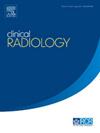浸润性乳腺导管癌淋巴血管浸润评估的多参数MRI深度学习模型:一项多中心回顾性研究
IF 1.9
3区 医学
Q2 RADIOLOGY, NUCLEAR MEDICINE & MEDICAL IMAGING
引用次数: 0
摘要
目的探讨基于多参数磁共振成像(MRI)的深度学习(DL)在预测浸润性乳腺导管癌(IBDC)淋巴血管浸润(LVI)状态中的价值。材料与方法对来自两个中心的448例IBDC患者进行回顾性分析,其中中心1分为训练集和验证集(8:2比例),中心2为检验集。使用MobileNetV2-3D DL模型比较T1WI-CE2和T1WI-CE3的性能,选择后者进行融合任务。该联合模型结合了临床放射学特征(CRF)和多参数MRI DL特征,以提高LVI的预测准确性。通过计算ROC曲线下面积(AUC)来评价模型的预测性能。校正曲线用于评估预测结果与观测结果之间的一致性。此外,决策曲线分析(DCA)量化了跨决策阈值的净收益。结果T1WI-CE3 DL模型在验证集和测试集的auc分别为0.842和0.774,优于T1WI-CE2 DL模型的auc分别为0.748和0.619。联合模型的验证集AUC为0.939,准确率为0.892;测试集AUC为0.941,准确率为0.872。校准曲线显示出良好的预测一致性,DCA证实了联合模型的临床实用性,支持其准确性、可靠性和应用潜力。本研究为IBDC患者术前LVI评估提供了一种新的工具,通过将多参数MRI与DL相结合,可能有助于临床医生制定更精确的治疗策略。本文章由计算机程序翻译,如有差异,请以英文原文为准。
Multi-parameter MRI deep learning model for lymphovascular invasion assessment in invasive breast ductal carcinoma: A multicenter, retrospective study
Aims
To investigate the value of multi-parametric magnetic resonance imaging (MRI)-based deep learning (DL) in predicting the Lymphovascular Invasion (LVI) status of invasive breast ductal cancer (IBDC).
Materials and Methods
A retrospective analysis of 448 IBDC patients from two centers was conducted, with Center 1 split into training and validation sets (8:2 ratio) and Center 2 used as the test set. A MobileNetV2-3D DL model was used to compare T1WI-CE2 and T1WI-CE3 performance, selecting the latter for fusion tasks. The combined model integrates clinical-radiological features (CRF) and multi-parameter MRI DL features to improve predictive accuracy for LVI. The predictive performance of the model was evaluated by calculating the area under the ROC curve (AUC). Calibration curves were used to evaluate the agreement between predicted outcomes and observations. Furthermore, decision curve analysis (DCA) quantified the net benefit across decision thresholds.
Results
The T1WI-CE3 DL model achieved AUCs of 0.842 and 0.774 on the validation and test sets, respectively, outperforming the T1WI-CE2 DL model, which had AUCs of 0.748 and 0.619. The combined model achieved a validation set AUC of 0.939 with 0.892 accuracy and a test set AUC of 0.941 with 0.872 accuracy. Calibration curves showed good prediction consistency, while DCA confirmed the combined model's clinical utility, supporting its accuracy, reliability, and potential for application.
Conclusions
This study offers a novel tool for preoperative LVI assessment in IBDC patients by integrating multi-parametric MRI with DL, potentially aiding clinicians in devising more precise treatment strategies.
求助全文
通过发布文献求助,成功后即可免费获取论文全文。
去求助
来源期刊

Clinical radiology
医学-核医学
CiteScore
4.70
自引率
3.80%
发文量
528
审稿时长
76 days
期刊介绍:
Clinical Radiology is published by Elsevier on behalf of The Royal College of Radiologists. Clinical Radiology is an International Journal bringing you original research, editorials and review articles on all aspects of diagnostic imaging, including:
• Computed tomography
• Magnetic resonance imaging
• Ultrasonography
• Digital radiology
• Interventional radiology
• Radiography
• Nuclear medicine
Papers on radiological protection, quality assurance, audit in radiology and matters relating to radiological training and education are also included. In addition, each issue contains correspondence, book reviews and notices of forthcoming events.
 求助内容:
求助内容: 应助结果提醒方式:
应助结果提醒方式:


